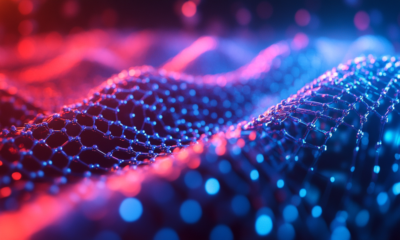Intelligence artificielle
Formation à l'IA par fibre optique : Un bond en avant basé sur la lumière
Securities.io maintient des normes éditoriales rigoureuses et peut recevoir une compensation pour les liens passés en revue. Nous ne sommes pas un conseiller en investissement enregistré et ceci n'est pas un conseil en investissement. Veuillez consulter notre divulgation de l'affiliation.

Why Optical Fiber Could Replace Electricity in AI Computing
Since the early days of informatique, almost all computers have been based on calculations using electricity in one way or another, from antique vacuum tubes to modern nanometer-scale silicon chips.
As silicon chips get smaller and smaller, researchers have been looking at new ways to build computers that could push our capacity further than silicon chips, a topic we explored in “Les 10 premières entreprises d'informatique hors silicium".
These methods include using different materials, like carbon carbide, vanadium dioxide, organic materials, or graphene, for example. Another way is to change how computing is done, moving away from the binary programming of electricity-based computing, which includes quantum computing and photonics.
Photonics uses light instead of electricity to encode and transfer information. However, until now, it has still been ultimately converted into a binary signal, failing to form a purely light-based form of computation.
This has changed with the work of researchers at the Tampere University (Finland) and Université Marie et Louis Pasteur (Besançon, France). They used optical fiber for ultrafast calculations and published their findings in the scientific journal Optics Letters1sous le titre "Limits of nonlinear and dispersive fiber propagation for an optical fiber-based extreme learning machine".
Limitations of Traditional AI Training With Electronic Systems
AI training and data processing are reaching limits in terms of efficiency, with AI computation increasingly constrained by energy consumption and the speed of data processing.
In contrast, light-based calculations have the potential to be thousands of times quicker and can encode data into tiny differences of energy, making it more efficient. The issue is that so far, no direct calculation using light has been performed.
The researchers’ work used a particular class of computing architecture known as an Extreme Learning Machine, (ELM) an approach inspired by neural networks.
Among some of their advantages, ELMs can learn from the training data in one step and are a relatively simple algorithm.
As a rule, ELM is unlikely to be useful for very complex tasks requiring multiple layers of AI training, but can perform very well and more efficiently for specific tasks, like visual recognition for example.
How Researchers Encoded Images Using Optical Fibers
The researchers used femtosecond laser pulses (a billion times shorter than a camera flash) and an optical fiber confining light in an area smaller than a fraction of human hair to build an optical ELM system.
The laser pulses are short enough to contain a large number of different wavelengths or colors, creating a rich dataset.
They then sent these data into the fiber with a relative delay encoded according to an image.

Source : Tampere University
The Role of Nonlinear Optics in AI Processing
This form of data encoding was transformed by the nonlinear interaction of light and glass.
Linear optics is the regular optics taught in school, where the light directly interacts with a prism, for example.
En optique non linéaire, la réaction du milieu dans lequel passe la lumière dépend de la longueur d'onde, de l'intensité, de la direction et de la polarisation de la lumière.
Nonlinear optical components can cause photons of different frequencies to combine and create new photons at new frequencies.
“Instead of using conventional electronics and algorithms, computation is achieved by taking advantage of the nonlinear interaction between intense light pulses and the glass.”
Mathilde Hary and Andrei Ermolaev – Post-Doctoral Researchers
Non-linear interaction and Extreme Learning Machine (ELM) algorithm was able to train an AI to classify handwritten digits (like those used in the popular MNIST AI benchmark).

Source : Optics Letters
The best systems reached an accuracy of over 91%, close to the state-of-the-art digital methods.
What makes the result exceptional is that it was achieved in under one picosecond, or one trillionth of a second (0.000000000001 seconds).
Ideal Optimization
The best results did not occur at the maximum level of nonlinear interaction or complexity.
Instead, they required a delicate balance between fiber length, dispersion (the propagation speed difference between different wavelengths), and power levels.
“Performance is not simply matter of pushing more power through the fiber. It depends on how precisely the light is initially structured, in other words how information is encoded, and how it interacts with the fiber properties.”
Are Optical Fiber Computers the Future of AI?
Training AIs with only light is a radical departure from all the methods used until now. This is likely not going to be a method possible to use for every type of data, but for the ones where it can be applied, this could bring results that are 1,000x more efficient in terms of energy, and as much as a million times quicker.
“Our models show how dispersion, nonlinearity and even quantum noise influence performance, providing critical knowledge for designing the next generation of hybrid optical-electronic AI systems.”
Most likely, such an approach would mean that some AI calculation would be delegated to a non-linear optical fiber hardware custom-built for the task. So repetitive tasks, like visual identification, would be the best candidates more than processing new data.
“This work demonstrates how fundamental research in nonlinear fiber optics can drive new approaches to computation. By merging physics and machine learning, we are opening new paths toward ultrafast and energy-efficient AI hardware.
Potential applications range from real-time signal processing to environmental monitoring and high-speed AI inference.
Such work is, however, still at the demonstration of basic principles of the technique stage, and far from a commercialization step.
It nevertheless demonstrates that photonics is likely going to be an increasingly important part of the computing industry moving forward, as light can be superior to electricity for some computing applications due to fundamental physics reasons.
Principales sociétés cotées en bourse dans le domaine des lasers et de la photonique
Cohérent (II-VI Marlow): Un leader dans l'innovation laser
Coherent, Inc. (COHR +4.61%)
Coherent est un grand conglomérat industriel qui emploie plus de 26 000 personnes et qui est un leader dans le domaine de la technologie laser. Il est issu de la fusion de l'entreprise de matériaux avancés II-VI Marlow avec le fabricant de lasers Coherent.
L'entreprise est experte en matériaux avancés utilisés dans les lasers, l'optique et la photonique, tels que le phosphure d'indium, les plaquettes épitaxiées et l'arséniure de gallium.
Elle s'est développée en grande partie grâce à de multiples acquisitions au cours de la dernière décennie, passant d'un chiffre d'affaires de $600M en 2013 à $4,7B en 2024.
The company derives 29% of its revenues from lasers directly, with the rest linked to associated equipment like optical fiber, and electronics. The instrumentation category mostly includes life
sciences and medical applications.

Source : Cohérent
La présence de l'entreprise dans les matériaux avancés tels que les thermophotovoltaïques (qui sont les plus utilisés dans l'industrie de l'énergie) a été renforcée. dont nous avons parlé dans un article précédent), le carbure de silicium, les lasers et l'électronique lui permet de bénéficier de tendances structurelles telles que la croissance de la fabrication de précision, de la fabrication additive (impression 3D), de l'électrification et des énergies renouvelables.
L'entreprise a a récemment séparé ses activités dans le domaine du carbure de silicium en une nouvelle entité, détenue à 75% par CoherentLe reste est détenu à parts égales par ses partenaires Mitsubishi Electric (qui apporte la propriété intellectuelle du carbure de silicium) et Denso (qui apporte son activité d'équipementier automobile dans le domaine de l'électrification et des semi-conducteurs de puissance).
En effet, le carbure de silicium est de plus en plus une technologie à part entière, principalement utilisée dans des applications à haute puissance telles que les véhicules électriques, les batteries et les énergies renouvelables.
Cohérent est un leader dans le domaine du LIDAR et de la détection numérique en 3D, y compris pour les applications de conduite autonomeBiotechnologie, biotechnologie Cellules à flux pour le séquençage de prochaine génération (NGS)et lasers pour la fabrication de semi-conducteurs. Elle s'attend à ce que ses principaux marchés connaissent une croissance de 8 à 20%.

Source : Cohérent
The other potential new applications of lasers, like direct energy weapons, photonic computing, nuclear fusion, and spacetech, could all equally help sustain the long-term growth of the company.
Dans l'ensemble, Coherent est aussi proche qu'il est possible de l'être d'une société de laser "pure play" cotée en bourse pour les investisseurs intéressés par le secteur, avec une forte intégration verticale et plus de 3 100 brevets protégeant ses innovations.
Les progrès de la photonique entraîneront une augmentation progressive de la demande de systèmes laser ultra-rapides et ultra-précis, ainsi que de lasers utilisés dans les télécommunications optiques.
Dernières nouvelles et évolutions de l'action Coherent (COHR)
Coherent (COHR) Surpasses Q1 Earnings and Revenue Estimates
3 Stocks to Buy From the Growing Technology Services Market
Is COHERENT CORP (COHR) Stock Outpacing Its Business Services Peers This Year?
Coherent: Quality Comes At A Price, But AI Tailwinds Could Push It Higher
Coherent Set to Report Q1 Earnings: What's in the Offing?
Coherent Corp : Bien positionné pour la croissance à long terme de l'infrastructure d'IA
Étude référencée
1. Andrei V. Ermolaev, Mathilde Hary, et al. Limits of nonlinear and dispersive fiber propagation for an optical fiber-based extreme learning machine. Optics Letters. Vol. 50, Issue 13, pp. 4166-4169 (2025) https://doi.org/10.1364/OL.562186














